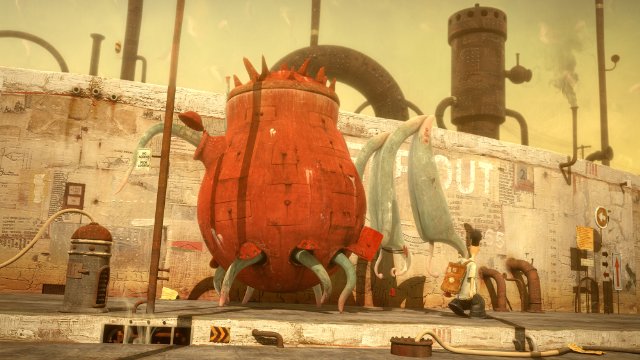
The Lost Thing is a beautiful 15-min animated short film based on the book by Shaun Tan, who is also director of the piece, along with Andrew Ruhemann. The film has won several awards, including an Academy Award for Best Animated Short Film.
I have interviewed John Kassab, sound designer on the project, and responsible of giving life sound to the characters, places and all the events of this amazing story. Perhaps you already know about him, since we’re talking about the same person who published that fantastic report called “The State of Post-Production Film Sound”, which was recently updated with new sections about conforming, SD to HD conversion, and an extended discussion about backgrounds. Download here (PDF).
Below is the interview I had with John, where we talked about specific elements, important scenes, techniques and methods applied, and more. Enjoy!
Designing Sound: John, could you please introduce yourself to the readers and tell us how did you get started in sound and what has been the evolution of your career?
John Kassab: My awareness of filmsound started early on when I awoke to the sound of The Exorcist (1973) playing in the living room when I was about 6 or 7. This track had a profound effect over me. Although I didn’t see a single frame, I don’t think I slept for the rest of that week. Since then, without any real understanding of how film sound was made, I have been all-ears. It wasn’t until I was about 12 when I heard the footsteps of the T-Rex in that famous scene form Jurassic Park (1993) that I really started to take particular notice to the craftsmanship. And when I heard the toilet shoot-out come horse vs motorcycle scene in True Lies (1994) in the following year at my local home theatre shop, I was positively hooked to the idea of working with film sound at some capacity – although in honesty, at that point I really wanted to be salesman at the home theatre shop so I can listen to Laser Disks to my heart’s content.

Almost a decade later I started university as a Law student who took some cinema classes on the side to keep sane. As the years rolled on I attended less and less of my law degree and become completely immersed in cinema until I (thankfully) dropped out of Law altogether. When I finished my undergrad in Cinema, I studied a short course in sound production purely out of interest. However, halfway through my course, a chance meeting led to an introduction to the head of sound of the South Australian Film Corporation, a tall guy by the name of Rory McGregor. We connected over a mutual enthusiasm for cinema and audio. Rory then introduced me to his colleague, re-recording mixer Pete Smith. Pete subsequently mentored me informally, for about a year. I spent a lot of time looking over his shoulder and trying not to get in the way or outstay my welcome.
When I did finally outstay my welcome, he and Rory recommended me for a 10 week paid internship under the SAFC’s attachment program on the feature film December Boys (2006) staring Daniel Radcliff. On this film I was very fortunately to have learned from some of the best people in the Australian film sound industry including Jenny Ward who was extremely helpful and whose lessons I still hear occasionally in my brain when cutting difficult lines of dialogue. I was even given the opportunity to design the rides in the carnival scene and amazingly most of the work made it all the way to the final print master. After this experience I decided to go independent as a sound designer, contacting and meeting with as many studios, filmmakers and film students that would agree to meet to talk about sound.
DS: Could you tell us about the approach of the director to the sound of The Lost Thing?
JK: Shaun Tan is a truly remarkable sound conscious director and I feel quite blessed and honored to have worked with him. Before this filmic endeavor, Shaun had predominantly worked in the silent and still mediums of painting and illustration. To his credit, he overcompensated for his apparent lack of experience with directing sound by completely immersing himself in a way that I have never seen or heard of a director doing.
Shaun started to collect lots of sounds from around his house with a domestic camcorder and cut them to the animatic using i-movie. He had even created some simple layered sound designs to better explain how he felt the world and its characters could sound. Some of the sound ideas where indeed quite brilliant and in a few occasions I re-created them with better quality recordings. And in a couple of other instances, I simply lifted them straight out of his animatic because of the ‘character’ that he had captured in those recordings. In the sound design, I really wanted to capture as much of Shaun as possible for his fans. Other than recordings he had made himself, I also included his voice in some of the backgrounds and sound recordings of his pet bird, Diego.
DS: What were your initial thoughts and preparation?
JK: My initial thought was that of being completely overwhelmed and then excited and then overwhelmed again. I realized very early on that this was a great opportunity to do something quite new and explore unchartered territory – at least for Australian filmmaking. The sound schedule ran concurrently with animation so I had roughly 13 or 14 months to work on the film. This allowed for a lot of time to experiment and to make loads of recordings. I started making recordings immediately in preparation for the project using the images from the book as a guide for the types of sounds I though I might need later in the project. I also recorded a lot of wild sounds with Foley artist Adrian Medhurst with a bunch of cool odds and ends he has lying around his studio.
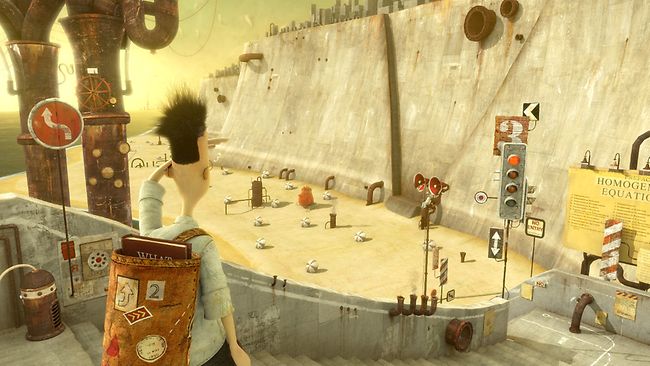
DS: Let’s talk about the world where the story is developed. What peculiarities features that place and how its features affect your sound design decisions?
JK: Shaun was also very clear about the mechanics of the world depicted in the film. He kept referring back to the idea of a futuristic world powered by steam, clogs and gears. It was futuristic in its rate of expansion and apparent lack of humanity but was still so old-fashioned in the way it operated and the technology it used. For example the trams are powered by roof mounted steam engines instead of electricity. He was also very good at communicating the materials, textures and feeling of the place – which is really handy when working to grey flat untendered 3d animation. These directions gave me clear boundaries to work within, but within those boundaries, he gave me a lot of creative freedom and space to go exploring, experiment and play.
DS: One of the themes of the film is that people don’t care about the lost thing. The two main characters walk inside the society, but no one cares about the Thing. How was that approached in terms of sound?
JK: That’s a great question. In short it was a really tricky balancing act. In every scene I considered 3 perspectives. The perspective of the main characters, the objective perspective of what was physically happening (or what the audience would be expecting to hear) and the perspective of the other characters in the film. These perspectives are constantly shifting in every scene – particularly as we regarded the locations themselves as characters in their own right and each required distinct sonic treatments and a moment to sing. With so much going on in every scene, it was all about weaving all of the elements in and around each other to tell the story of character and place whilst taking care not to overcrowd the track at any one point. I am a huge believer in less is more so when dealing with the more chaotic scenes in this film, rather than leaving things out, I gave lots of little moments of relevance to lots of different things to shine. The character sounds of The Lost Thing, and his public perception, was just another element to weave in and out as the story required it.
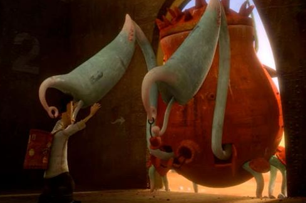 DS: How did you manage to design the sounds of the Lost Thing itself?
DS: How did you manage to design the sounds of the Lost Thing itself?
JK: This was a very collaborative effort between the very excellent Foley genius that is Adrian Medhurst, Shaun, myself – and eventually the re-recording mixer Doron Kipen who refined our work further to fit around the music and voice over. Basically Shaun wanted LT to sound rusty and metallic but as light on his feet as an excitable puppy. That is, he wanted us to convey his massive physicality and texture but refrain from making him sound earth shattering heavy unless the story or performance called for it.
As LT is made up for lots of components (feet, hinges, bells, mouth lid, claws, doors, cooling fan, internal mechanics, vocalisations, etc) our first instinct was to over-track his movements at every occasion. We also had the extreme luxury of time so we really wanted to explore every possibility and try lots of different things for everything. Shaun really got into that too.
As a general rule, I write Foley notes for Adrian to track the external sounds as he has many useful tools in the treasure chest in his Foley room and I took the internal sounds and vocalizations. Of course as sound people working with a fun character like this, we couldn’t help our selves and we both over-stepped those boundaries on every occasion completely merging our roles beyond those of sound designer or Foley artist respectively.
However, the final sound of LT, as he is heard in the film, only really came to being towards the end of the project when I started pre-mixing him. Playtime was over. During this process I was ruthless, I would decide which sounds where absolutely relevant to a particular moment in the story and ditch everything else. In the end, about 90% of the original sounds are eventually heard, just not all at the same time – or even in the same scene. And listening to it now, I would probably kill a further 25% of LT’s bells.
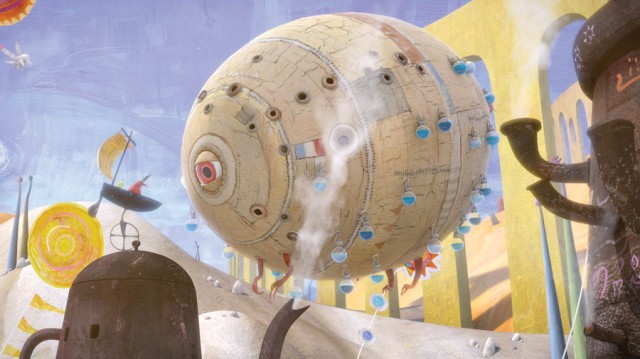
DS: I guess the Utopia scene was a blast. Not only for its importance in the whole film, but also for the variety of characters and performances. Could you tell us how was your process on that scene?
JK: When I signed on to this project, the wonderful lone animator and editor Leo Baker had almost completed the big ‘Utopia’ sequence; which was the first scene to be animated and one that was continually readdressed until the end of the project 13 months later. So I started on this scene right away.
I must admit it was very intimidating looking at 40 or so semi-mechanical creatures flying passed the camera in one and a half minutes of footage. Each character needed a distinct sound and I was constantly fearful of letting down the fans of the original book. And animation, by nature of the medium, is so deadly silent when given to the sound department. Every sound I layered in against silence stood out and sounded horribly stark and wrong. A painter friend told me that he has a similar problem when he paints on a white canvas. He said that he always paints on a grey background to ease him into it and suggested I find my grey paint. With his advice I found a piece of music that I felt suited the images and sentiment of the scene and started to fill in the pictures with sound.
I highly recommend this technique to anyone facing the same problem, but just remember to mute the music track before the client comes in the room, as it can be a little embarrassing.
Adrian Medhurst was again completely instrumental in the creation of these sounds. He tracked a lot of the feet and other subtleties that reinforced the performances which gave weight, personality and, ultimately, life to the creatures. He and I also recorded a huge number of wild recordings of various sounds that were used as the basis for electronic manipulation. I also used a lot soft synthesis in the creation the musical and sub bass sounds. I absolutely love the synths in Reason and I used these on many of the character sounds in this sequence.
DS: What kind of sources did you record for the film? How was the palette of sounds you created for this project?
JK: At final count I had used 1836 original sound recording on this 15 min film -which was probably over doing it a little. This does not including all of the synthesized sounds and little bits and pieces that we threw in from Shaun’s work on the animatic.
Most of the sounds where short recordings Adrian and I made of props form our respective treasure chests. I became obsessed with going through second hand shops and looking for things that made sounds. Any sounds. I would think what character, place, moment can I use this sound. Because the project spanned many months, this lead to a pretty massive collection of crap for future projects.
I also hired a sound effects recordist by the name of Bart Bee. We ran around the oil refineries and other factories around the industrial western suburbs of Melbourne. We dodged security guards in the middle of the night on a covert mission to find steam blasts, chugging sounds, engines, pipe rattles and other metallic vibrations. Unfortunately the security guards eventual found us and we were escorted out of the area. Security guards generally don’t like to see Middle Eastern men in the middle of the night holding 2 pistol mics pointed at an energy plant. But they let us go and we got to keep our sounds. Which was a good thing as these sounds formed the basis of many of the locations depicted in the film.
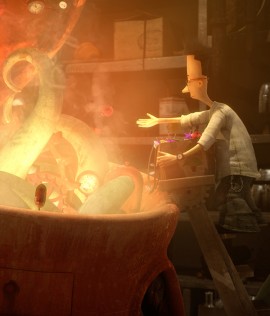
DS: What was your biggest challenge on “The Lost Thing”? is there anything you would have done differently?
JK: Conforming, re-conforming and then conforming some more.
The film was animated out of sequence and the sound department was working at the same time as Leo Baker was animating. So we were working on it scene by scene and in some instances, shot by shot. There were various basic assemblies made of the film but picture lock didn’t take place until the 40-something version which was well after the sound design was completed. I was determined to keep everything virtual until the final mix so it was no easy task cutting and moving all of the little sounds around and making it work. Especially when there where animation changes within the cut changes.. eek.
On the upside though, working at the same time as animation and assembly gave the sound department collaborative input on the way some of the cuts were made to retain the musical and rhythmic integrity of the sound design. It’s a truly rare thing when a sound designer can ask picture department for a few more or less frames here and there to make the sound work better. I was very grateful for this flexibility and it made the pacing of the overall film better.
If I was to do this project again I would probably commit to a lot more of the sounds and record things down to track. For example if a character is made up of 6 sounds, during pre-mixing, I would be more decisive and turn the character into 1 mono sound to be more easily cut and re-panned if necessary in the final mix. Same for the backgrounds. Some of the scenes used 20 or more tracks when you factor in the industrial sounds, water lapping in the foreground, winds in the mid ground, as well as the various perspective shifts and transition sounds. There was very little reason to keep these tracks completely virtual and in hindsight I wished that I just committed the elements into a series of manageable 5.1 tracks. This would have made things a lot easier to have less tracks when we where racing the clock with all of these revisions moments before the very tight final mixing schedule.
I am also so very thankful that my dear friend Daniel Varricchio who was able to come on at the end of the project to help out with this task. The track may have never been completed in time if it were not for his extra set of hands and ears to get everything back in sync. In the end I think there are 2 or 3 sounds that are slightly out of sync – not sure if anyone has noticed. However, given the work involved during this process and what little time and resources we had at our disposal, I am very happy with the end result.
Incredibly interesting article. Very inspiring as well! Great to know about the techniques and thoughts involved in the making. I found what you said about the multiple ‘points of hearing’ very useful. Thanks a lot to both (Miguel and John). I haven’t been able to watch the whole film but I watched the clip on John’s page and found it very enjoyable. I’ve been a fan of Shaun Tan’s illustration for some time and always wondered how his worlds would sound. John’s version definitely fulfilled those expectations. Loved the timing, textures and perspectives. Can’t wait to hear the rest!
Yes, I agree with Carlos, very interesting. Thanks!!!